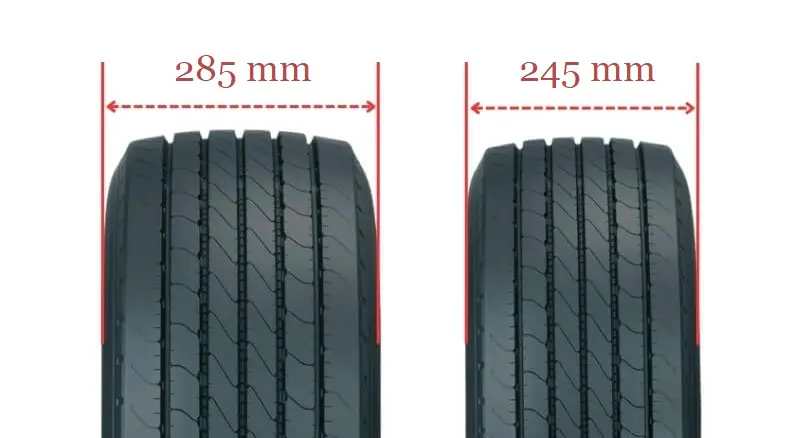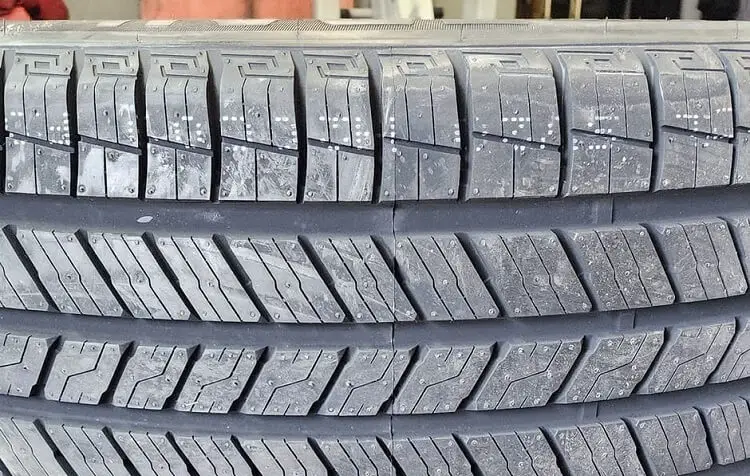245 vs 285 Tires

The main difference between 245 and 285 Tires tires is in the section width. The tire size 285 is about 40 millimeter wider than 245 tire size. The wider width of the tire can impact its performance and appearance when installed on the vehicle.
245 vs 285 Tires
| 285 Tire | 245 Tire |
|---|---|
| Lower Gas Mileage due to more rolling resistance and rotational mass | Higher Gas Mileage due to smaller contact patch and lower weight |
| More comfortable ride due to wider contact patch and taller sidewall | Less comfortable ride with smaller contact patch |
| More aggressive look but worse for aerodynamics | Better for aerodynamics but less aggressive aesthetics |
| Improved stability and traction, good for off-road | Enhanced handling and response, better for on-road |
| Potentially more road noise, less vibration | Quieter on smooth roads, more vibration from irregularities |
| Endures impacts but causes more component wear | Potential for longer tread life and even wear |
| Higher due to larger contact patch | Lower due to smaller contact patch |
| Better traction in mud, snow, off-road | Can cut through snow/ice more effectively |
Gas Mileage
With a slightly smaller contact patch and less rotational mass, 245 tires generally confer better fuel efficiency, an aspect crucial for daily commuters and long-distance travelers.
The larger 285 tires might detract from fuel efficiency owing to increased rolling resistance and rotational mass from the heavier weight.
Ride Comfort
The wider 285 tires generally offer a more comfortable ride than 245 tires due to their wider contact patch and taller sidewall.
However, the 245s tend to perform better on-road, while the 285s are better suited for off-road driving.

Aesthetics
The 245 tires contribute positively to vehicle aerodynamics, whereas 285 tires can offer a more aggressive and aesthetic appeal but may hinder aerodynamic efficiency.
Ultimately, tire choice comes down to finding the right balance of form and function based on intended vehicle use.
Handling & Stability
Due to the more minor contact patch, the 245 tires typically offer enhanced handling and quicker response on paved roads.
Conversely, the wider 285 tires might present improved stability and traction, particularly in off-road scenarios or on uneven surfaces because of the larger contact area.
Noise & Vibration
The 245 tires may provide a quieter ride on smooth surfaces but might transmit more vibrations from road irregularities.
The 285 tires, especially those with aggressive treads, might generate more road noise but could also dampen vibrations.

Durability & Wear
The 245 tires can potentially exhibit even wear and potentially longer tread life. While the 285 tires might endure more impacts, they also absorb more stress, introducing more wear to vehicle components due to their added weight.
Load Capacity
The load capacity increases with the 285’s wider tire width because it has a larger contact patch to distribute weight over a wider area. The 245 would have a decreased load capacity by comparison.
Adverse Conditions
The narrower 245 tires can sometimes navigate snow and ice more effectively by cutting through to the road surface compared to the 285 tires. However, the wider 285 tires provide better traction in specific off-road or muddy conditions.

Difference Between 245 and 285 Tires
The main difference is the section width, with 285 tires being 40mm wider than 245 tires. This impacts tire performance, including handling, traction, and ride comfort.
Can I Use 285 Tires Instead of 245
Yes, you can use 285 tires instead of 245 tires. The rim width ranges for these sizes overlap, with 245 tires fitting 7.5-9.0 inch rims and 285 tires fitting 9.0-10.5 inch rims, allowing for compatibility.
Keep in mind that although the rim widths overlap, the aspect ratio and rim diameter of the new tires should match your current setup.
If the aspect ratio or rim diameter does not match, the overall diameter difference should stay within 3% to avoid affecting speedometer accuracy and vehicle performance.

Can I Use 245 Tires Instead of 285
Yes, it is possible to use 245 tires instead of 285 tires. The overlap in rim width ranges (7.5-9.0 inches for 245 tires, 9.0-10.5 inches for 285 tires) indicates potential compatibility.
It’s crucial to select options with an aspect ratio and rim diameter that match your existing setup. If an exact match is not feasible, aim to keep the overall diameter difference within a 3% threshold to maintain accurate speedometer readings and optimal vehicle performance.
Can I Put 285 Tires on 245 Rims
Yes, you can put 285 tires on rims designed for 245 tires, as the ideal rim width range for 245 tires (7.5-9.0 inches) overlaps with the range for 285 tires (9.0-10.5 inches).
Can I Put 245 Tires on 285 Rims
Yes, it is possible to put 245 tires on rims meant for 285 tires, as the ideal rim width range for 285 tires (9.0-10.5 inches) overlaps with the range for 245 tires (7.5-9.0 inches).

Meet Caitlin McCormack, a Tire Size Expert and Blogger Passionate About Everything Related to Tires. With Years of Experience in the Tire Industry, Caitlin Has Become an Expert in Tire Sizes and Their Impact on Vehicle Performance.
